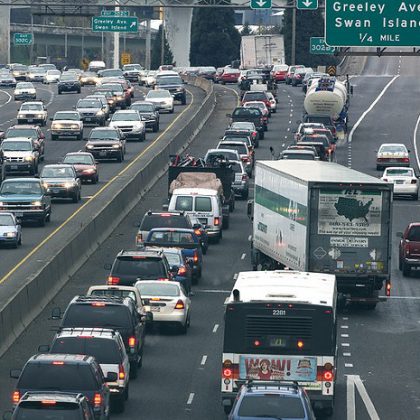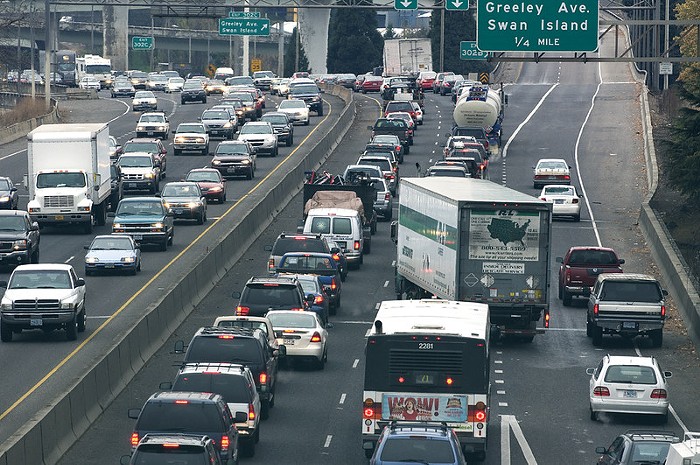Feature your business, services, products, events & news. Submit Website.
Breaking Top Featured Content:
Environmental, Equity Groups Skeptical of ODOT’s Tolling Plans


A plan to add tolling to Portland-area freeways is starting to take shape through the Oregon Department of Transportation’s (ODOT) Tolling Program.
While the program has far more questions than answers—like what sections of the freeways will be tolled, what the toll rates will be, and how much revenue it could generate—some environmental and equity advocates are already raising concerns over how the transportation department will prioritize setting and spending the tolls.
The Oregon Legislature directed ODOT leaders to design a tolling system for portions of Interstate 5 and Interstate 205 in Portland in a 2017 transportation bill. The bill mandated the Oregon Transportation Commission (OTC), ODOT’s governing body, to research how highway tolls could be used to reduce traffic congestion through Portland during peak driving times. So far, ODOT has settled on using a type of tolling called congestion pricing, where the cost of the toll will vary depending on how busy the roads are. According to ODOT, the toll price will vary throughout the day but remain on a set schedule, so drivers will always know what the toll is prior to getting on the road.
Tolls on I-205 will be introduced in late 2024 at the earliest, followed by tolling starting on I-5 in 2026.
The eventual revenue from these tolls will be used to maintain the tolling system, as well as fund ODOT’s major transportation projects in the Portland area, like the $1.25 billion Rose Quarter Improvement Project, the repaving and addition of two lanes on a portion of I-205, and the upcoming plan to replace the I-5 Interstate Bridge. Given those projects alone add up to several billion dollars of undetermined funding, some environmental advocacy groups are suspicious of how ODOT will balance fair toll prices with its need for funding.
“I think the result will be people wind up paying far more than they would need to just manage congestion,” said Chris Smith of No More Freeways, an environmental advocacy group.
No More Freeways has long advocated for ODOT to use congestion pricing, particularly in the I-5 Rose Quarter corridor where ODOT is also planning to add additional freeway lanes to address traffic congestion. No More Freeways believes the state should use congestion pricing to improve traffic flow prior to adding lanes to the freeway. This theory is backed by studies, including one commissioned by ODOT, that show increasing traffic lanes will increase the number of cars using the road, and only relieves congestion temporarily.
While No More Freeways supports congestion pricing as a way to lower carbon emissions, Smith says ODOT’s planned use of the toll revenue to fund additional projects that expand freeway corridors, like the I-5 Rose Quarter and I-205 projects, could undermine any environmental benefits. Oregon has committed to reducing its carbon emissions to 80 percent below its 1990 levels by 2050. With transportation accounting for 36 percent of the state’s greenhouse gas emissions, ODOT plays a significant role in achieving the state’s climate goals.
In an effort to fund transportation projects—as well as community traffic safety projects that may arise as drivers seek out alternative, non-tolled routes—Smith believes ODOT will be juggling too many priorities when it comes time to actually set the toll price. Smith says true congestion pricing is only put in place during peak driving times when drivers need to be discouraged off the roads to improve traffic flow, whereas ODOT is opting for a permanent toll that is increased during high-traffic periods.
“With true congestion pricing, your objective is to make the transportation facility work for its purpose,” said Smith. “If you limit your pricing to cover the periods when there’s truly congestion, you won’t generate enough revenue to pay for these projects, much less have money left over for transit, biking, and walking.”
According to ODOT spokesperson Tia Williams, “toll rates will be set as low as possible” as long as they meet the department’s objectives of reducing congestion and raising revenue for transportation projects. In an effort to keep the impacts of tolling equitable, ODOT has convened an Equity and Mobility Advisory Committee (EMAC) to guide how the tolling program will spend toll revenue on projects that will benefit community safety and prevent potential disproportionate impacts tolling may have on low-income drivers and communities located on routes that may see an increase in traffic due to drivers trying to avoid freeway tolls. The committee includes 15 people with professional or lived experience with equity and mobility issues.
However, the EMAC will not know how much money is available for equity-based projects until after they make their recommendations on how the money should be used. The timeline has caused some frustration among the committee members.
“I’m a little bit caught off guard hearing that the toll rates and the known potential revenue will not actually be set until six months before day one [of tolling],” said Kari Schlosshauer, EMAC member and Pacific Northwest Policy Manager for Safe Routes Partnership, a nonprofit advocating for pedestrian safety, during a September EMAC meeting. “I feel like we’re in a little bit of a black box in terms of what we’re recommending.”
The unknown of how much money ODOT will have available to fund equity projects limits the EMAC’s ability to make specific project and spending recommendations. Instead, the committee will create a guiding equity framework that ODOT will use to decide how they prioritize equity-related spending.
“The first thing we have to do is pay the bills,” ODOT’s Toll Program Manager Lucinda Broussard said during the September EMAC meeting. But, Broussard emphasized that ODOT is “weaving” the value of equity throughout the toll program, not leaving it as something to fund with whatever is left over after paying the bills.
“I know those sound like good words now because we have no tangible assets to it, but our goal is to have tangible assets in equity,” Broussard told the committee. “Right now I know we don’t [have tangible assets], but the recommendations are the start.”
ODOT will release more details about tolling locations in Spring 2022 after completing an assessment of how introducing tolls on the freeways will impact the surrounding roadways.
Continue Reading at PortlandMercury.com here
